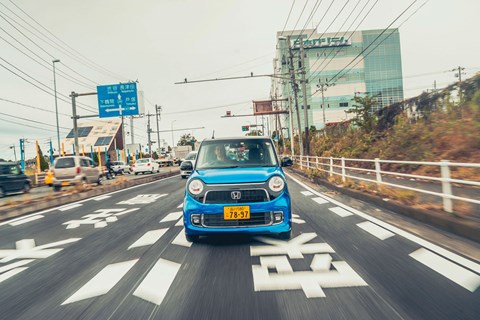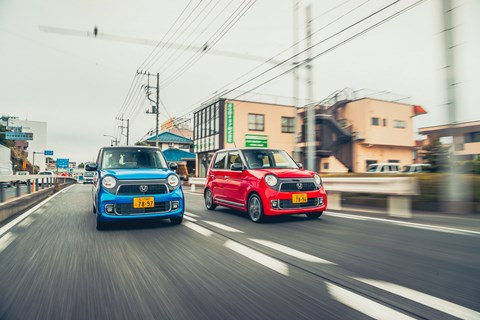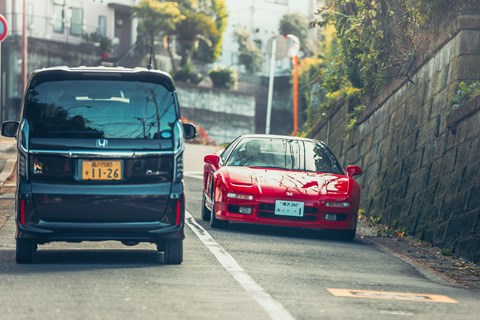► Tiny turbo Honda takes on Tokyo traffic
► 658cc triple, 850kg, less than £10k
► Terrific fun, occasionally terrifying
1) The N-One is as cute as pie (if not quite as cute as Honda’s Urban EV Concept)
At the Frankfurt show earlier in 2017 Honda melted hearts and captured imaginations with its Urban EV Concept, a zero-emission, retro-futuristic mash-up that made you want to buy one immediately and cuddle it so hard you creased all the panels.
While the Urban EV Concept was a shock at Frankfurt, certainly next to AMG’s traditionally steroidal Project One hypercar, in design terms the Urban EV’s a clear evolution of the current-generation N-One, a kei car Honda’s offered for sale in Japan since 2012.

Honda has the second biggest slice of Japan’s domestic sales pie after Toyota, and kei cars comprise around a fifth of the market. On Tokyo’s roads they are absolutely everywhere. Kei cars must, like a Ryan Air cabin bag, fit within a restricted box of dimensions (hence the boxy styling) and, unlike a Ryan Air cabin bag, must not boast an engine capacity in excess of 660cc. Originally developed as affordable post-war transport, the type has since been encouraged in Japan with tax breaks – the N-One Premium weighs in at 1490,000 yen (£9950), or half the price of a Civic in Japan.
A nostalgic nod to the N360, one of Honda’s earliest passenger cars, the four-door N-One comes in a rainbow of colour options, looks like a Nintendo hero on wheels and measures less than 1500mm wide by 3395mm long and 1610mm high, giving it the proportions of a tubby wardrobe.

2) A turbo 658cc triple has never felt so good
Red light. A young Japanese guy on a frame-scrapingly low scooter sits impatiently in the next lane, throttle idly blipping through a silencer that doesn’t. Behind you there’s delivery truck, chrome polished to a glaring mirror finish and its driver wearing a mask of grim determination.
The tension swells. Quietly, deliberately, you tug the N-One’s gearlever down to Sport and click the right steering wheel paddle for the first of the CVT gearbox’s seven ratios. Foot-handbrake off; breathe.
Green. Bam. In one fluid movement your foot’s off the brake and onto the gas, the 850kg Honda launching cleanly as the 658cc double-overhead camshaft turbo triple gets down to business. There’s decent drive from 2000rpm and beyond, a decent shove in the back as peak twist (48lb ft) chimes in at 4700rpm and a fulsome 57bhp at 7300rpm.
Predictably the scooter blares past. But the truck’s toast, another victim of the N-One’s unexpectedly healthy turn of speed. In city traffic a little grunt goes a long way and N-One’s get-up-and-go inspires the confidence to go on the offensive. Which is faintly hilarious when you stop to remember both how meagre its crash structure is and how ridiculous you look hustling a car so cute it makes babies gurgle with joy.

3) This kei is no twisty-road giant-slayer
If the N-One’s lusty off-the-line performance comes a surprise, its indifference to hurrying through corners won’t. While the Honda carries its weight low and pushes a wheel to each of its four corners, its creators were clearly terrified by the idea of anyone achieving any meaningful corner speed.
To deter heroics they’ve thoughtfully fitted flat, friction-free seats, dim-witted steering that asks for armfuls of lock before changing trajectory, plentiful body roll and grip so modest that if it does all go wrong it’ll be at the kind of speeds cyclists crash at. Still, so low are most of the speed limits on Japan’s interesting roads that it’s almost a moot point. For example the winding, undulating ski run of a drive from the capital to Honda’s Twin Ring Motegi circuit is hobbled by a 50km/h limit along its entire length. 658cc are all you need.

4) Even in the world of kei cars, there’s a hierarchy
Cheap, light and simple the N-One Premium might be, but in the land of kei it’s pretty posh. There’s cruise control, a raft of airbags, a transmission that won’t let you roll downhill if you’re sitting still in drive or reverse, collision detection, folding rear seats and VSA stability control.
And above the N-One is the N-Box, its less cute but significantly more comfortable older brother. Performance is comparable to the N-One’s since weight and power are limited by kei rules but the N-Box enjoys a roomier cockpit (there are buses with less headroom), more standard equipment and greater refinement. Top of the tree though is the S660 sports car, modern successor to the classic Beat and, in the wrong hands on a serpentine toll road in the rain, a whole heap of fun/trouble.

5) Tokyo’s automotive culture is insanely distracting
Cool old motorbikes ridden by absolutely everyone, from schoolkids to pensioners. Immaculate Lamborghinis. People movers with black windows, no ground clearance and open exhausts. All the modified Subarus, Nissans and Hondas you’d expect, many of them restrained, tasteful and, in the context of Tokyo, achingly desirable. And then there are the kei cars. Swarms of them. And a good number are the likable if uncomfortable, cute yet gutsy Honda N-One.